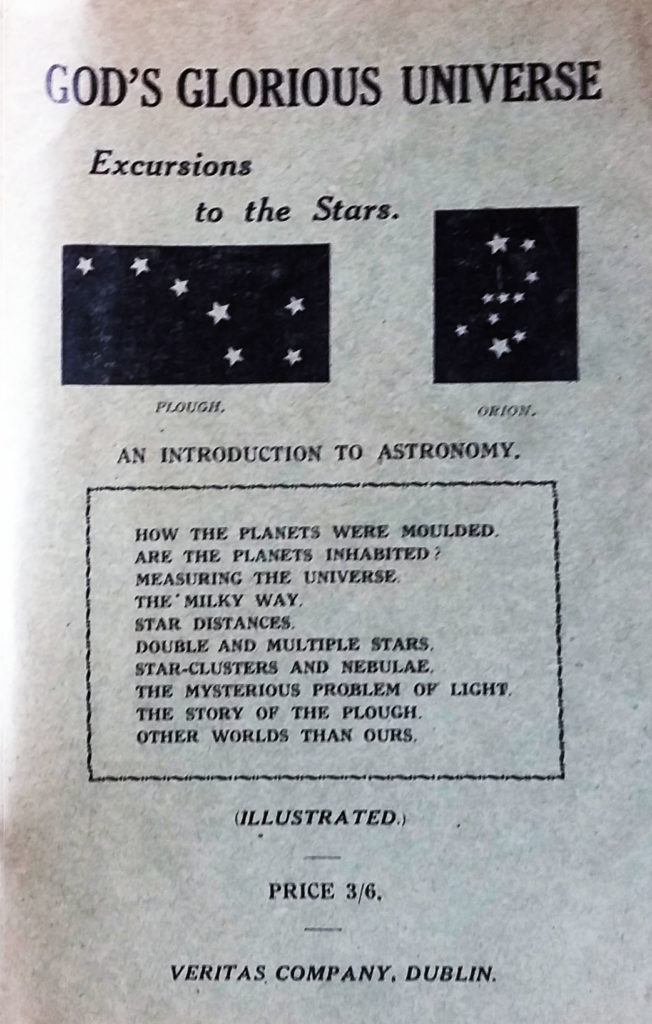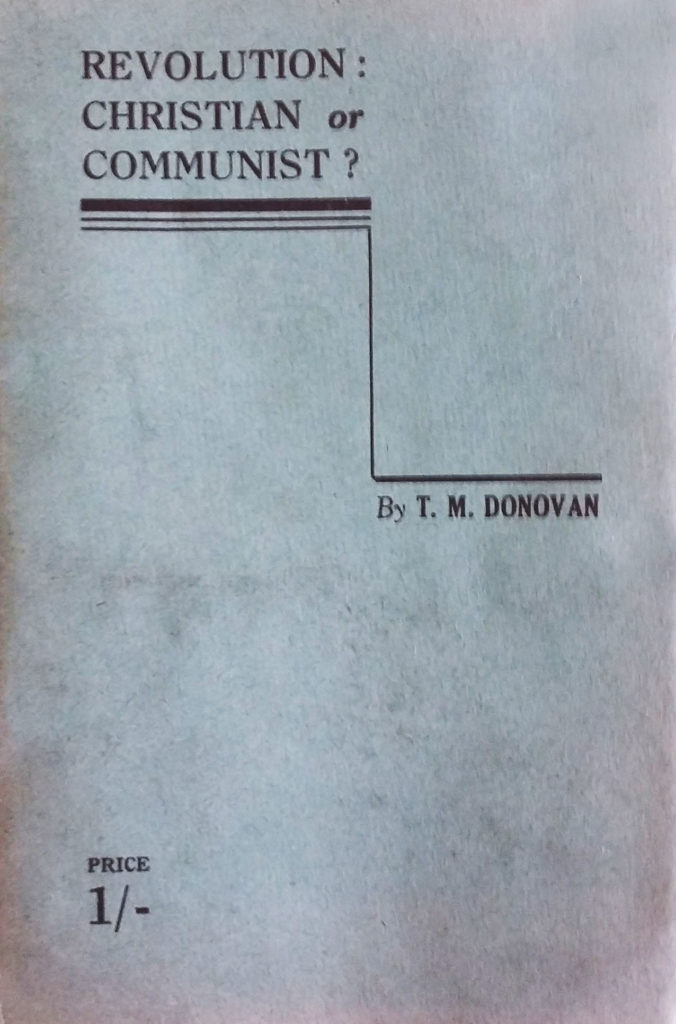T M Donovan, Castleisland’s prolific author of the early twentieth century, published his first book, A Popular History of East Kerry in 1931. The Two Mothers appeared in 1933.[1]
In the intervening year, God’s Glorious Universe was published. It first appeared as a series of articles in the Kerryman from about March to May 1932. A notice of its production in book form was published in November 1932:
God’s Glorious Universe by T M Donovan will shortly be published by the Veritas Company, Dublin, and Sands and Co, London. It is a defence of Christianity, while giving an introduction to the oldest and grandest of the sciences – astronomy.[2]
Its subject matter, astronomy, was far removed from the local history which had formed the subject of his previous (and subsequent) publication. During composition of the book, Donovan had been unwell:
Last year when I was writing my book, God’s Glorious Universe, little I thought that the radium I described in one of its chapters would be used on my own body before a year had passed. Under the care of Dr James M O’Donovan, a professor in University College Cork, a plaque of radium was applied to my face in order to cut away a growth that if not cleaned off might ultimately finish me off.[3]
When the book hit the shelves in late 1932, reviews were generally positive – a work ‘written to reach the man and woman of most ordinary education.’ Among the notices came endorsement from Rev Daniel J McHugh (1877-1965), CM, Professor of Science at DePaul University, Chicago, Fellow of the Royal Astronomical Society of Great Britain and a leading member of the American Association for the Advancement of Science. It appeared in the Journal of Religious Instruction, Chicago:[4]
The author makes no pretensions at being a great astronomer. The author has condensed in readable form a great deal of astronomical knowledge, at the same time injecting his own deep faith, poetry and sense of humour. The photographic plates are well chosen and distributed.[5]
However, behind the scenes, in Castleisland, Donovan was distraught. He had received a letter from Veritas, his publisher, on Christmas Eve 1932 to inform him the book would be withdrawn as it contained statements ‘contrary to Catholic doctrine.’[6]
Donovan fought back, ‘I am putting the whole case before Cardinal McRory and showing that the Veritas reader censored the page proofs in September – two months ago. I am marking all paragraphs which may contain the condemned statements.’[7]
Donovan also condemned as ‘outrageous’ a review of the book in the Irish News, which he described as ‘faked.’ His final judgment was that the censorship arose because of differences between church and science:
The real reason is that the official publishers cannot take the side of Catholic theologians who believe in the development of the universe in aeons of time …without mentioning the real objection to the book – the age of the universe, which the Veritas censor corrected – the Irish News reviewer had orders to kill the book, and this literary bandit carried out the directions with great malice and stupidity.
Today, the book is hard to find; surviving copies are held mainly in academic institutions.

A multum in parvo little volume, but large in its sociological import and literary value – Review of Revolution: Christian or Communist?[8]
Donovan again tackled the contentious five years later with the publication, in 1937, of Revolution: Christian or Communist?.[9] It was described as ‘a warning to Ireland, North, and South alike, that unless they compose their differences both will be overrun by Communism within a few years’:[10]
One reviewer opined, ‘The more the topics Mr Donovan touches upon are discussed today, the better for the future of Ireland,’ adding, ‘Though some of Mr Donovan’s assertions are likely to be hotly challenged, his sincerity and zeal are manifest.’[11]
Donovan’s assertions were certainly challenged. A few days after the appearance of an article about the work in the Leader: a Review of Current Affairs, Politics, Literature, Art and Industry, a threat was made against him:
The Cork IRA, probably a Mallow group, made the attempt, here in Castleisland, to kidnap me and probably pour tar over me, and leave me laid out in some Co Cork by-road.[12]
Donovan, however, lived to tell his tale and in the 1930s and 40s, he had the foresight to submit copies of his work to the National Library of Ireland, thus creating his own archive.[13] His submissions contained notes about his struggles with publication in terms of cost and censorship. He described the background to the publication of Revolution:
In early 1936, the Irish Christian Front read the manuscript and promised me that the Central Council and its branches would undertake the sale and distribution of it, if I paid for the printing. I did pay printers £50 but when it was ready for reviews, the Irish Christian Front was dying rapidly, and left me ‘in the soup.’ I lost £30 on its publication.[14]
Six years after publication, Donovan was also able to reflect on one of the chapters of his book, and comment on its subject, the Irish Republican Communist Front:
Sean MacBride and the editor of Ireland Today were two of the intelligentsia inspiring this Front. The Kerryman of the 8 May 1943 reports a speech of great length of Sean McBride’s urging a similar organization now against the De Valerian government; but he is now ready to advise against the totalitarian objective of 1936! He probably remembers that Wm Norton TD had to withdraw the first plank of the labour programme – ‘A Workers Republic.’ The teachers, the distributive workers and railway unions and a few of the smaller ones, were against it so the Workers Republican flag had to be hauled down privately.[15]
The outspoken courageous Donovan, author of the recently reproduced To Queensland With Love, never gave up on the value he placed on his work. In April 1948, as an octogenarian, he wrote to Browne & Nolan Ltd, Publishers, Dublin, enclosing a copy of Revolution, seeking to have the work reprinted. The publishing manager thanked him for his trouble but replied, ‘We doubt very much that the book would command a sufficient market.’

_______________________
[1] Further reference, http://www.odonohoearchive.com/the-two-mothers-a-portrait-of-castleisland-in-the-1930s/. [2] The book appears to have been reprinted in 1937. [3] Kerryman, 27 May 1933. [4] February issue, 1934. [5] Kerryman, 24 February 1934. [6] Donovan Papers, National Library of Ireland, PC 896. Objection appears to have come from two sources, Fr O’Reilly of the Veritas Company, and ‘a learned critic’ of the Irish News. Donovan’s comment was written in the marginals of a copy of God's Glorious Universe held in PC896: ‘On Xmas Eve, 1932, I got a letter from Veritas Company informing me that a theologian says that there are statements in this book of mine contrary to Catholic doctrine! A strange and most astonishing addendum – they ‘are to withdraw the book from circulation’ – an anti-materialist book – a book inspired throughout by my Catholic faith! Something in high theology or in Catholic philosophy that is quite beyond me, I hope. Xmas Day 1932. T M Donovan.’ Donovan further notes: ‘I was so distressed that my writing in these marginals was very shaky, first written in pencil and afterwards inked over by me.’ [7] TM Donovan 25 December 1932. Donovan Papers, National Library of Ireland, PC 896. The following day, 26 December 1932, Donovan noted: ‘There is not even a trace of pantheism in this book and its conclusions are anti-materialist throughout. It is an outrageous libel to say that this book may be as dangerous as the ‘science’ of H G Wells.’ [8] Kerry News, 7 April 1937. [9] As with God’s Glorious Universe, the book is rare, a few copies to be found in academic institutions. It contains 14 chapters: 1 Revolution: Christian or Communist?; 2 Communism and Irish Politics; 3 The Campaign for Social Justice; 4 A United Christian Front; 5 The Menace of Socialism; 6 Communist Propaganda; 7 The Christian State; 8 The Authority of the Bishops; 9 An Appeal for Unity; 10 Whom will ye have as Guide?; 11 Dark Clouds over Europe; 12 A United Ireland; 13 A Workers Republic means Communism; 14 Communism in Action. [10] The Kerryman, 28 August 1937. ‘The Free State is as riddled by Communism as a board may be eaten by white ants; he appeals to Roman Catholics and Protestants to forget their differences and to unite as a Christian front ... Unless this is done a savage civil war through the North and the South is inevitable.’ Donovan provided his own description of the work: ‘An elaboration of the aims and objectives of the Irish Christian Front – the establishment of a social order in accordance with the Papal Encyclicals, and an attempt to rouse the people of Ireland to the immediate danger in the Six and the Twenty-six counties from Communist organisations and propaganda ... Many do not realise that we have in Ireland at the present day nearly all the factors that went to the making of the Revolution in Spain. Small farmers practically illiterate, are on the breadline; thousands of workmen are unemployed; our young men grown to manhood cannot make a living, settle down and marry – hence the dance hall mania exploited by the revolutionaries for their own evil ends; the undermining of their Catholic faith by a contemptuous rejection of the authorities of the bishops. Large areas of ranch-lands still undivided. No real Catholic Action as in Belgium for helping the peasant and rural workers; no Catholic Trade Unions; no uplift organisations for the training of idle hands and in most of our towns, no allotment associations; few Catholic Boy Scouts in rural parishes – in a word, plenty of associations for devout Catholics already on their way safely to heaven, but practically nothing for the discontented men and boys without hope or occupation’ (Cork Examiner, 16 June 1937). [11] Sunday Independent, 13 June 1937. [12] Donovan Papers, National Library of Ireland, PC 896. ‘To the National Library 19.11.42. Five days after the disclosures of chapters V and VI appeared first in The Leader as an article in that weekly, the Cork IRA probably a Mallow group, made the attempt, here in Castleisland, to kidnap me and probably pour tar over me, and leave me laid out in some Co Cork by-road. I could identify the three – one of whom looked a wild fanatic with staring eyes.’ The Dublin Leader – Leader: a Review of Current Affairs, Politics, Literature, Art and Industry – was published weekly 1900-1971. Donovan alludes to issue of 17 July 1937. The publication is held in the National Library of Ireland. [13] Donovan Papers, National Library of Ireland, PC 896. The material is as yet uncatalogued. [14] Donovan Papers, National Library of Ireland, PC 896. Comment on page 124 of Revolution. The Irish Christian Front (ICF) was a Catholic organisation that existed from August 1936 to October 1937. [15] Chapter XIII, ‘A Workers Republic means Communism’ pp98 & 99. Donovan Papers, National Library of Ireland, PC 896. Comment dated 9 May 1943.


